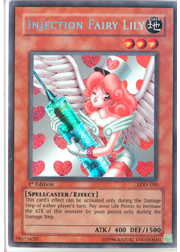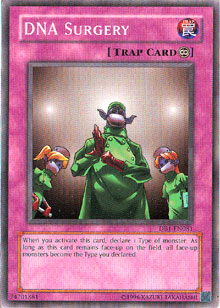“Divide the ranks accordingly, then dispose of anyone unfit for battle.”
 Rivalry of Warlords is a good friend to any deck that focuses on one specific type of monster. Decks that rely on multiple monsters from a variety of types can try to work around it, but the constant balancing act can be quite irritating.
Rivalry of Warlords is a good friend to any deck that focuses on one specific type of monster. Decks that rely on multiple monsters from a variety of types can try to work around it, but the constant balancing act can be quite irritating.
Rivalry of Warlords is, in my opinion, one of the most confusing cards in the game. It’s caused me a fair amount of frustration in the past, and there’s no doubt that it’s done the same for judges and players alike. However, when you break down its effect, it becomes much more manageable. Today, we begin our two-part coverage of Rivalry of Warlords.
Divide the Ranks
For reference, the text of Rivalry of Warlords says, “Each player sends monsters from his/her side of the field to the Graveyard so that he/she only controls 1 Type of monster. As long as this card remains on the field, each player can only have 1 Type of monster on the field.”
When Rivalry of Warlords resolves, each player looks at all of the monsters that he or she has face up on his or her side of the field, examining each monster’s type. He or she chooses a type that he or she wants to keep from among the monsters on his or her side of the field. We’ll refer to this selection as the “active monster type.” After deciding, he or she then takes any face-up monsters on his or her side of the field that are not of that type and sends them to the graveyard.
Each player is free to pick a different monster type, or they can both choose the same monster type. Each player handles his or her side of the field separately and isn’t bound by the decision that the opponent makes. However, both players must pick a type from among the monster types they already control, so it isn’t possible to choose to keep a monster type that isn’t already on their respective sides of the field.
Example: Dividing the Ranks
Brandon has a face-up Lava Golem and a face-up Injection Fairy Lily on his side of the field. Cecilia has two face-up Solar Flare Dragons and a face-up Cannon Soldier on her side of the field. Cecilia activates Rivalry of Warlords. When it resolves, Brandon and Cecilia look at the monsters on their respective sides of the field and see that they each control a total of two monster types. Brandon has a Fiend-type monster and a Spellcaster-type Monster, while Cecilia has two Pyro-type monsters and a Machine-type monster.
 Brandon and Cecilia must now each decide which monster type is more important to them, and send any face up monsters on their side of the field that don’t have that monster type to the graveyard. Brandon could choose to keep “Fiend” as his monster type, losing Injection Fairy Lily, or he could choose “Spellcaster” and lose Lava Golem instead. Cecilia could choose to keep “Pyro” and lose her Cannon Soldier, or she could choose “Machine” and lose the two Solar Flare Dragons instead.
Brandon and Cecilia must now each decide which monster type is more important to them, and send any face up monsters on their side of the field that don’t have that monster type to the graveyard. Brandon could choose to keep “Fiend” as his monster type, losing Injection Fairy Lily, or he could choose “Spellcaster” and lose Lava Golem instead. Cecilia could choose to keep “Pyro” and lose her Cannon Soldier, or she could choose “Machine” and lose the two Solar Flare Dragons instead.
If Brandon had a copy of Exiled Force in his hand, could he have chosen “Warrior” as his active monster type? With only Fiend-type and Spellcaster-type monsters face up on his side of the field, it wouldn’t be possible for him to select “Warrior” as his active monster type, because he didn’t control any face up Warrior-type monsters on his side of the field when Rivalry of Warlords was resolved. The monster type choice was Brandon’s to make, but it had to be a monster type that he had on the field at the time Rivalry of Warlords was resolved.
Once the decisions are made, both players are bound by the remainder of Rivalry of Warlords’ effect. From this point on, each player is only allowed to control face up monsters that all share the same monster type. He or she won’t be able to normal summon or special summon any monster onto the field if it has a monster type that’s different than the face-up monster or monsters that he or she control on the field.
In our example, if Brandon selects to keep his Spellcaster-type monster Injection Fairy Lily, he won’t be able to normal summon or special summon any other monsters unless they’re also Spellcaster-type monsters. If Cecilia keeps her Solar Flare Dragons, she won’t be able to normal or special summon any other monsters, unless they are also Pyro-type monsters.
Monster Type Lock-In?
Is there a way around this? There most definitely is. You see, when a player no longer controls any face-up monsters, they are free to normal summon, flip summon, or special summon a monster of any type they desire. The newly summoned monster will then determine the active monster type that that player controls. This means that the active monster type is flexible, and it can easily change over the course of the game.
Example: Troop Exchange
Brandon continues his game against Cecilia. After ditching Lava Golem with Rivalry of Warlords, Brandon uses Destruction Ring to destroy his Injection Fairy Lily and inflict 1000 points of damage to both his and Cecilia’s life points. Now that he no longer controls any face up monsters, he no longer has an active monster type, and is free to normal summon or special summon a monster of any type that he desires. After doing so, whatever monster he summons will determine his active monster type, and it’ll remain this way until he no longer controls any face-up monsters.
What about Cecilia? With two face-up Pyro-type monsters on her side of the field, she could be stuck with Pyro-type monsters for quite some time. Is there anything that she can do?
Well, why not tribute them both? If you can manage to tribute every face-up monster on your side of the field, you will be able to tribute summon a monster of any type you desire. The act of tributing all of your face up monsters allows you to free yourself from the previous active monster type. The newly tribute summoned monster will determine your new active monster type. Naturally, this doesn’t mean you can just tribute monsters for no reason, or tribute more monsters than necessary. Rivalry of Warlords doesn’t augment game mechanics in this way.
As the game progresses, each player’s active monster type is likely to change, especially in decks that contain a variety of monster types. As long as each player follows the rule and only controls one monster type among their face-up monsters, they will be fine.
 You can also overcome the active monster type limitation by using the trap card DNA Surgery to change the type of all the face-up monsters on the field. By doing this, you’ll establish an ongoing unity among the types of your face-up monsters, allowing you to summon any monster you want without worrying about Rivalry of Warlords. However, if DNA Surgery is removed from the field while Rivalry of Warlords is active, you’ll lose this unity and will once again be forced to re-decide your active monster type.
You can also overcome the active monster type limitation by using the trap card DNA Surgery to change the type of all the face-up monsters on the field. By doing this, you’ll establish an ongoing unity among the types of your face-up monsters, allowing you to summon any monster you want without worrying about Rivalry of Warlords. However, if DNA Surgery is removed from the field while Rivalry of Warlords is active, you’ll lose this unity and will once again be forced to re-decide your active monster type.
Rivalry of Warlords and Face-Down Monsters
What will happen if a player has a face down monster on his or her side of the field when Rivalry of Warlords resolves? Since the monster is face down, its type cannot be determined. With its monster type unspecified, it isn’t included in the resolution of Rivalry of Warlords. You will not examine its monster type, nor will you send it to the graveyard. It will simply remain where it is.
But the face-down monster itself will still be limited by the remainder of Rivalry of Warlords’ effect that prevents either player from controlling more than one type of monster. If Cecilia chooses to keep her Solar Flare Dragons by choosing the Pyro type, she won’t be able to flip summon her face-down Stealth Bird, because it’s a Winged-Beast-type monster and not a Pyro-type monster.
A face-down monster that’s flipped face up while Rivalry of Warlords is active will become bound by its effect, and this can have some serious consequences for the player who controls it. What happens when a player’s face-down monster is attacked or flipped by a card effect during the course of the game? How will we handle that situation?
To find out the answers to these questions and learn more about Rivalry of Warlords interactions, be sure to return next week for our conclusion!
Send all questions, comments, and observations to Curtis@metagame.com.